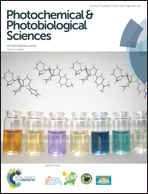Investigation on the capability of polysulphone for measuring biologically effective solar UV exposures
Abstract
Polysulphone (PS) dosimetry is a well-known technique broadly used to assess the erythemally effective solar UV dose received by anatomical sites (personal exposure). We investigate the capability of PS dosimetry to convert doses absorbed by PS badges into biologically effective solar UV exposures taking as examples two relevant effects for human skin: erythema induction and pre-vitamin D3 production. PS calibration curves for erythemal and pre-vitamin D3 were distinctly determined by using an empirical relationship between the biologically effective UV exposures and the PS absorbance change. This relationship is parameterized by a coefficient, distinct for each of the two considered biological effects, multiplying the same cubic polynomial function. It is shown how the multiplying coefficient is related to the ratio between the biologically effective and the PS weighted irradiances which is the prevailing factor affecting the accuracy of the calibration and, consequently, the capability of PS films for measuring biologically effective solar UV exposures. The points addressed in this paper can be extended to other biological effects of interest whose action spectra have some similarity with the PS film response.


 Please wait while we load your content...
Please wait while we load your content...